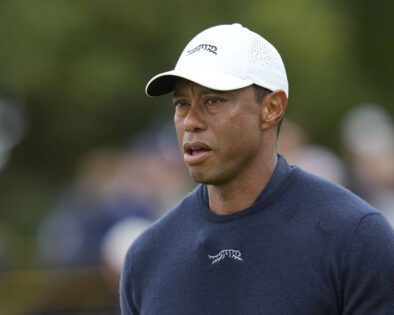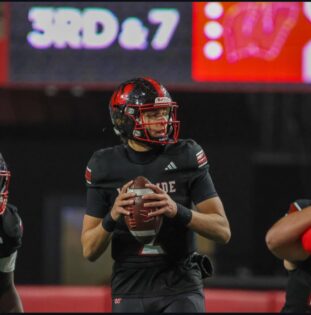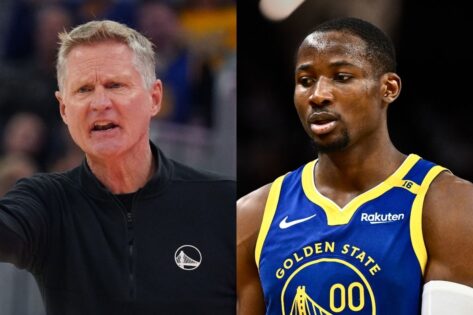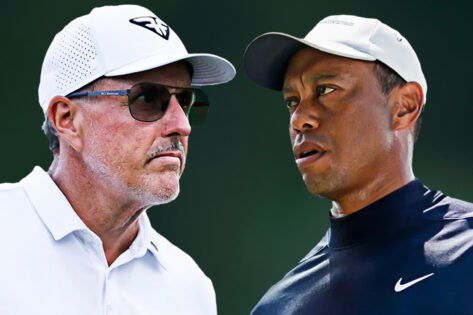For over a decade, Tiger Woods and his then caddie operated as arguably the most formidable duo in modern golf. From 1999 to 2011, the partnership between the greatest golfer of his generation and his data-driven, fiercely loyal caddie helped produce a stretch of dominance the sport had never seen. Together, they amassed 13 major championships, countless tournament wins, and a mystique that reshaped golf’s competitive standard.
That caddie was Steve Williams, a New Zealander known for his meticulous preparation, blunt honesty, and unwavering work ethic. Williams became an essential part of Woods’s inner circle during his peak years, often acting as strategist, motivator, and protector on the course. One stretch stands out above all: the Tiger Slam. Between June 2000 and April 2001, Woods won four consecutive majors: the U.S. Open at Pebble Beach by 15 shots, the Open Championship at St. Andrews by eight, the PGA Championship at Valhalla in a playoff, and the Masters at Augusta the following spring. It remains the only time in modern golf history that a player has held all four major titles at once.
2000-2001: Tiger did the impossible.
He held all four majors at once – the “Tiger Slam.”
U.S. Open victory margin? 15 strokes.
Still untouchable.
And the numbers kept climbing: pic.twitter.com/1ScLbhUHwL
— Tim Carden (@timjcarden) June 28, 2025
Woods’s win at St. Andrews, in particular, has been called the most clinical performance of his career. He didn’t hit a single ball into a bunker and finished at 19-under, nine shots ahead of the field. That performance, and the mindset behind it, was the subject of a revealing live interview with Steve Williams on The Yardage Book Podcast, where he discussed his new memoir Together We Roared.
When asked whether he anticipated the level of golf Woods achieved in 2000–2001, Williams responded simply: “100% not.” He went on to describe Woods’s extraordinary standards, recalling that even winning by a record margin wasn’t enough to satisfy him. “And one of the most unusual things about Tiger — he didn’t celebrate. It was always on to the next thing, the next major.” According to Williams, moments after winning the 2000 U.S. Open at Pebble Beach by 15 shots, still the largest major victory margin in history, Woods emerged from the scoring hut and immediately focused on the next target. “The next thing he says is, ‘Steve, I’m going to play even better in St. Andrews. You get your ass over there and you know every blade of grass on that course.’” This relentless mindset, Williams said, defined Woods’s career, and made working with him uniquely demanding. True to his word, Woods crushed the field at the Old Course three weeks later by nine strokes. “And to his credit, in the 12 years that I caddied for him, that was his best 72-hole performance.”
But the drive didn’t stop there. Tiger quickly turned his attention to the PGA Championship at Valhalla. And again, he demanded perfection. “‘Okay, the PGA. Steve, you need to get to Valhalla. Get your ass to Valhalla and keep this thing rolling.’ So, there was this — the pressure of working for someone like that was immense,” Williams shared. The Yardage Book interview also touched on Williams’s advanced preparation—painstakingly compiling stats, crafting detailed yardage books, and analyzing every nuance of Woods’s game. This effort helped fuel Tiger’s supremacy, but it also came at a personal cost. Williams admitted that working for Woods meant absorbing a level of intensity few could match. But even the most successful partnerships aren’t immune to strain. As the wins piled up and the expectations escalated, so too did the pressure, and eventually, the cracks began to show.
The fallout and the final word: ‘Together We Roared’
Despite 13 major wins together, Woods and Williams parted ways in 2011 under abrupt circumstances. When Woods withdrew from a tournament and Williams took a one-off caddie job for Adam Scott—after getting Woods’s initial blessing—Woods reportedly changed his mind and dismissed him soon after. The firing came via phone call and caught Williams off guard, ending a 12-year partnership that had shaped both men’s careers.
In the years that followed, Williams voiced frustration with how it ended and made some controversial remarks, including calling Scott’s win with him “the best of my life.” Yet Woods, despite the awkwardness, publicly defended Williams against accusations of racism after a separate comment drew backlash, saying, “Steve is not a racist.” After more than a decade of silence between them, the two reportedly reconnected—an emotional moment that Williams recounts in his new book—Together We Roared, co-written with journalist Evin Priest. In the book, Williams describes their unexpected reunion at the 2023 Genesis Invitational, where Woods greeted him warmly in the Riviera clubhouse lobby. The gesture marked a turning point in a relationship once strained by their abrupt 2011 split. Released earlier this year, the memoir offers an unfiltered look at the highs, lows, and immense pressure of caddying for one of the most demanding and dominant athletes in sports history.
Williams not only tells the inside story of the Tiger Slam and the legendary chip-in at the 2005 Masters, but also provides a rare perspective on what it’s like to stand shoulder to shoulder with greatness—and still feel the weight of every swing. As the book makes clear, the success was historic. The cost? For Steve Williams, it was the constant, consuming pressure of trying to keep pace with someone who never stopped moving forward.
The post Tiger Woods’s Ex-Employee Reveals ‘Unusual’ Trait That Put Him Under Immense Pressure appeared first on EssentiallySports.



